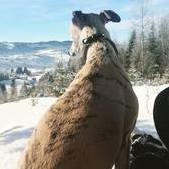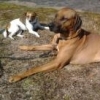-
Hvem er aktive 0 medlemmer
- Ingen innloggede medlemmer aktive
-
Nye innlegg
-
Kontakt raseklubben eller NKK for veiledning om dette. Det er ikke veldig vanlig, men det skjer at en oppdretter "leier" en tispe for et kull. De betaler da selvfølgelig alle utgifter i forbindelse med kullet, men jeg er usikker på om de betaler noe mer enn det til eier, jeg mistenker det er tilsvarende prisen av en valp, evt. en av valpene.
-
Spør for en jeg kjenner. Oppdretter ønsker at kjøper står som eier. Men vil ha ett kull på tispa. For vil ha genene videre. Hvordan foregår dette vs. forvert? Er ikke forvertavtale. Enten at kjøper har ett kull eller at oppdretter har kull der?
-
Ja, jeg «liker» jo å tro alderen har en stor rolle. Det sies jo at en bc trenger ett år på hvert bein, og ett for hode for å bli voksen. Vi gir oss ikke, men rimelig frustrende å se hvordan oppførselen hans har blitt, når jeg vet at han i bunn og grunn er helt super på alt annet. Vi var blant annet på ferie ett par dager i sommer. Mye hunder å møte her og der, men ingen hilsing. Og det var ikke noe problem. Han lå fint ved siden av meg å så hunder og folk på 10-20 meters avstand, ingen reaksjon. Det er jo sånn sosialisering bør være. Bare se og observere, uten noe mer. Samme når han er med på jobb. Men det er vel som du sier at mye av det vil vel skinne igjennom da han får landet litt.
-
Det høres ut som et bra hundeliv. For å svare direkte på spørsmålet så tenker jeg nok at alderen spiller en rolle for at det oppleves verre, men det kan gå begge veier avhengig av hva man gjør med det. Generelt er det greit å tanke at all adferd som hunden får erfaring med blir den bedre på. Hvis hovedregelen blir å utagere på andre hunder som passerer så vil det henge igjen når hunden modner og blir voksen. Hvis dere trener på å ha kontakt og slappe av rundt andre hunder så vil det etterhvert bryte gjennom hormontåka. Lykke til!
-
Mulig jeg formulerte meg litt feil. Men nei, han har nok ikke øvd på det i 18 mnd. Det har gått fint frem til 16-17 mnd alderen. Vi har også gått tur å kommet rett i ett hundestevne, da var det veldig mye hunder, men han brøy seg ikke merkeverdig da heller. Da gikk han bare å snuste. Mulig fordi det ikke var en enkelt hund å henge seg oppi. Han er ganske aktiv i form av søk, og vi trekker og sykler. Verken overstimulert eller understimulert vil jeg tro. Rolig og fin rundt baby på 4 mnd også. Jeg er klar over at vi må trene passeringer med større avstand for å ha kontakt. Har lest en hel haug om det. Bare nysgjerrig på mer med tanke på alderen hans osv.
-
-
Nylig opprettede emner


Recommended Posts
Join the conversation
You can post now and register later. If you have an account, sign in now to post with your account.